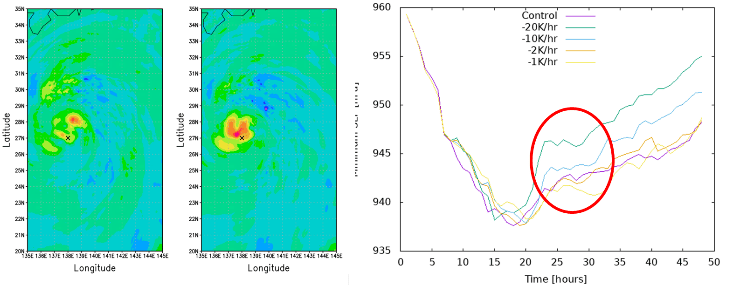Progress Report
Typhoon Control Research Aiming for a Safe and Prosperous Society[1] Meteorological Approach
Progress until FY2024
1. Outline of the project
We will develop a more accurate numerical prediction model that represents the internal structure of typhoons in detail and that can be used to control typhoons effectively. Specifically, methods to control typhoons by seeding, lowering sea surface temperatures, weakening surface winds, changing wind direction by placing barriers and wind turbines on the sea, etc., will be considered to change typhoon intensity. We also consider methods to change typhoons with continuous weak intervention. Assuming seeding from aircraft, we will conduct laboratory experiments to investigate the details of cloud physics in convective clouds. We will select cases that have the potential to cause disasters by predicting them in advance and assimilate aircraft and ship observation data into a data assimilation system based on a high-resolution model to improve the accuracy of prediction to the extent that the effects of human intervention can be judged and to improve typhoon predictions with high accuracy.
2. Outcome so far
In the 2024 fiscal year, we evaluated changes in wind speed, sea surface pressure, and other parameters in response to intervention intensity across various methods targeting significant typhoons that caused major disasters in Japan. The intervention methods examined included the seeding of cloud condensation nuclei in the lower layers of typhoons, that of ice crystal nuclei in the upper layers, cooling of the lower typhoon layers through seawater fountain, and increasing sea surface friction through the deployment of resistance structures. We evaluated each intervention method from the perspectives of artificial forcing mechanisms, typhoon structural changes, the extent of human intervention, the mechanisms of structural changes caused by intervention, costs and benefits, and social acceptability, and advanced the identification of promising methods.
This year, we conducted numerical simulation experiments to investigate the effectiveness of interventions for typhoon control from various perspectives. Based on these results, we presented criteria for identifying candidate intervention methods that can reduce typhoon damage to a level acceptable to society.
We conducted numerical simulations that mimicked artificial forcing by seeding cloud condensation nuclei (CCN) at an altitude of 1–3 km near the center of Typhoon Nanmadol in 2022. In the experiment where CCN were increased (Figure 1, right), the wind speed on the north side of the typhoon center weakened.


Assuming the intervention of upper-level ice crystal nuclei, we artificially froze supercooled water droplets. This showed that even a one-hour artificial freezing in the inner core region (within a radius of 50 km from the center) could result in significant changes in typhoon intensity. Furthermore, an experiment was conducted to freeze supercooled water droplets within convective bursts occurring in the inner core region during typhoon development, resulting in a central pressure increase of 15–20 hPa. These results suggest that artificially freezing supercooled water droplets may be an effective method for reducing typhoon intensity.
In a large-scale eddy simulation covering the entire typhoon, we conducted simulations assuming the placement of multiple large sailing ships as resistance to winds. The results are shown in Figure 2. We found that the location of the maximum wind speed changed.
Various approaches to artificially intervening in the rainbands within typhoons showed the possibility of inducing changes. On the other hand, It has become clear that highly coordinated intervention in terms of location and timing is necessary in order to influence the overall structure and intensity of a typhoon. The mechanisms underlying changes in the internal structure of typhoons, including the eyewall and rainbands, represent scientifically challenging issues. Further research is needed to elucidate these mechanisms both theoretically and observationally, in accordance with the objectives of this study.

3. Future plans
In the 2024 fiscal year, the third year of the project, we summarized the results of experiments on intervention methods for typhoon control based on numerical simulations conducted to date and identified candidate methods to be prioritized for future research. Meanwhile, in numerical simulations targeting typhoon cases, it is necessary to continue systematic investigations into the theoretical and numerical relationships between the intensity of artificial intervention and its impact on typhoon intensity. To proceed with the project, we need to explore efficient methods for human intervention using mathematical techniques. In particular, regarding research on numerical simulations, we will advance multifaceted and systematic studies while keeping in mind the potential of methods such as seeding techniques, seawater dispersion, and the placement of resistance bodies. We will also conduct parallel research on improving typhoon prediction accuracy, analyzing typhoon structures using satellite observation data, and changes in typhoon properties such as intensity due to the progression of global warming. We will clarify the mechanisms of changes in typhoon internal structures that cause typhoon intensity changes and advance mathematical research on mechanisms that produce large effects with small external forces.